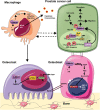Androgen Receptor-CaMKK2 Axis in Prostate Cancer and Bone Microenvironment
- PMID: 29967592
- PMCID: PMC6015873
- DOI: 10.3389/fendo.2018.00335
Androgen Receptor-CaMKK2 Axis in Prostate Cancer and Bone Microenvironment
Abstract
The skeletal system is of paramount importance in advanced stage prostate cancer (PCa) as it is the preferred site of metastasis. Complex mechanisms are employed sequentially by PCa cells to home to and colonize the bone. Bone-resident PCa cells then recruit osteoblasts (OBs), osteoclasts (OCs), and macrophages within the niche into entities that promote cancer cell growth and survival. Since PCa is heavily reliant on androgens for growth and survival, androgen-deprivation therapy (ADT) is the standard of care for advanced disease. Although it significantly improves survival rates, ADT detrimentally affects bone health and significantly increases the risk of fractures. Moreover, whereas the majority patients with advanced PCa respond favorably to androgen deprivation, most experience a relapse of the disease to a hormone-refractory form within 1-2 years of ADT. The tumor adapts to surviving under low testosterone conditions by selecting for mutations in the androgen receptor (AR) that constitutively activate it. Thus, AR signaling remains active in PCa cells and aids in its survival under low levels of circulating androgens and additionally allows the cancer cells to manipulate the bone microenvironment to fuel its growth. Hence, AR and its downstream effectors are attractive targets for therapeutic interventions against PCa. Ca2+/calmodulin-dependent protein kinase kinase 2 (CaMKK2), was recently identified as a key downstream target of AR in coordinating PCa cell growth, survival, and migration. Additionally, this multifunctional serine/threonine protein kinase is a critical mediator of bone remodeling and macrophage function, thus emerging as an attractive therapeutic target downstream of AR in controlling metastatic PCa and preventing ADT-induced bone loss. Here, we discuss the role played by AR-CaMKK2 signaling axis in PCa survival, metabolism, cell growth, and migration as well as the cell-intrinsic roles of CaMKK2 in OBs, OCs, and macrophages within the bone microenvironment.
Keywords: CAMKK2; androgen-deprivation therapy; bone–tumor microenvironment; castrate-resistant prostate cancer; treatment induced bone loss.
Figures

Similar articles
-
Down-regulation of calcium/calmodulin-dependent protein kinase kinase 2 by androgen deprivation induces castration-resistant prostate cancer.Prostate. 2012 Dec 1;72(16):1789-801. doi: 10.1002/pros.22533. Epub 2012 May 1. Prostate. 2012. PMID: 22549914
-
Nucleoporin 62 and Ca(2+)/calmodulin dependent kinase kinase 2 regulate androgen receptor activity in castrate resistant prostate cancer cells.Prostate. 2016 Feb 15;76(3):294-306. doi: 10.1002/pros.23121. Epub 2015 Nov 10. Prostate. 2016. PMID: 26552607
-
Androgen receptors in hormone-dependent and castration-resistant prostate cancer.Pharmacol Ther. 2013 Dec;140(3):223-38. doi: 10.1016/j.pharmthera.2013.07.003. Epub 2013 Jul 13. Pharmacol Ther. 2013. PMID: 23859952 Review.
-
Suppressive Role of Androgen/Androgen Receptor Signaling via Chemokines on Prostate Cancer Cells.J Clin Med. 2019 Mar 13;8(3):354. doi: 10.3390/jcm8030354. J Clin Med. 2019. PMID: 30871130 Free PMC article. Review.
-
Androgen action in the prostate gland.Minerva Urol Nefrol. 2012 Mar;64(1):35-49. Minerva Urol Nefrol. 2012. PMID: 22402316 Review.
Cited by
-
CaMKK2 Promotes the Progression of Ovarian Carcinoma through the PI3K/PDK1/Akt Axis.Comput Math Methods Med. 2022 Mar 11;2022:7187940. doi: 10.1155/2022/7187940. eCollection 2022. Comput Math Methods Med. 2022. Retraction in: Comput Math Methods Med. 2023 Jun 28;2023:9860912. doi: 10.1155/2023/9860912. PMID: 35309839 Free PMC article. Retracted.
-
Prostate Cancer Energetics and Biosynthesis.Adv Exp Med Biol. 2019;1210:185-237. doi: 10.1007/978-3-030-32656-2_10. Adv Exp Med Biol. 2019. PMID: 31900911 Free PMC article. Review.
-
The Roles of Tumor-Associated Macrophages in Prostate Cancer.J Oncol. 2022 Sep 7;2022:8580043. doi: 10.1155/2022/8580043. eCollection 2022. J Oncol. 2022. PMID: 36117852 Free PMC article. Review.
-
Androgen receptor signaling and spatial chromatin organization in castration-resistant prostate cancer.Front Med (Lausanne). 2022 Jul 29;9:924087. doi: 10.3389/fmed.2022.924087. eCollection 2022. Front Med (Lausanne). 2022. PMID: 35966880 Free PMC article. Review.
-
Advances in landscape and related therapeutic targets of the prostate tumor microenvironment.Acta Biochim Biophys Sin (Shanghai). 2023 Jun 9;55(6):956-973. doi: 10.3724/abbs.2023092. Acta Biochim Biophys Sin (Shanghai). 2023. PMID: 37294106 Free PMC article. Review.
References
-
- Noone AM, Howlader N, Krapcho M, Miller D, Brest A, Yu M, et al. editors. SEER Cancer Statistics Review, 1975–2015. Bethesda, MD: National Cancer Institute; (2017). Available from: https://seer.cancer.gov/csr/1975_2015/ (Accessed: April, 2018).
Publication types
Grants and funding
LinkOut - more resources
Full Text Sources
Other Literature Sources
Research Materials
Miscellaneous

